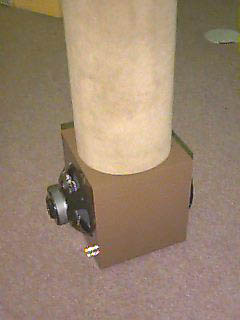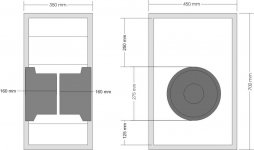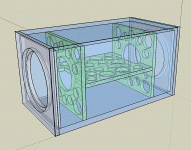Thats ver similar to my new design, except I have 18's and the W and D of the box is a bit greater.Ap said:Have finally settled on my new sub desing, its using two 10" drivers mounted back to back in push-push configuration.
Just wondering if anyone knows if there is a limit to how close the magnets can be too each ohter, I'm hoping 20mm is Ok - any idea?
It will depend to an extent on how much power you're going to play through them and whather they have vented polepieces, As an idea, my drivers are rated for 1000W, and the sims indicate 40Hz at extremely high levels will be <100W/driver, heat won't be an issue. Run very hard, I'd put the driver motors on the outside for cooling.
Ap said:Thanks Dave,
the drivers have vented pole pieces - can you suggest a suitable material to wedge - MDF Ok?
Andrew.
MDF is kinda squishy... a piece of hardwood is most practical.
dave
I have heard of people successfully implementing push push designs and getting much lower levels of distortion. This makes sense based upon the fact that the equal and opposite forces should cancel. I have been doing this in my designs for a long while now and have found that if your box is not properly designed, placing the magnets directly against each other will lead to further benefits, and yes MDF will be fine contrary to some other's beliefs. In my experience, hardwood is much more deformable than MDF. In my humble opinion this is a good design and I would love for you to share your results with us!
Thad
Thad
Actually, with both magnets facing eachother, this design is more of a bipole than push-pull. I'm not too sure that a bipole setup would eliminate distortion all that much. Maybe some because two drivers working together would be doing half the work of one driver at the same freq and output, but that's it.
A true push-pull design would be like my sub or some of the larger M&K subs where one driver is mounted normally with the basket inside the enclosure and the second driver mounted inverted with the basket outside the enclosure. This inverted driver would also be wired 180* out of phase but would remain mechanically in phase.
The cancellation of even order harmonics comes from both drivers moving in opposite directions of eachother, cancelling out their own distortions from the motor, suspension and cone.
This is a small piece taken from Dan Marx's website... http://www.danmarx.org/audioinnovation/theories.html
"According to M&K who specialize is push/pull subwoofers claim that this approach cancels out even ordered harmonics. So take your pick. Either way, harmonic distortion is reduced in that any anomalies or variations in the two driver's spider, cone or suspension characteristics are canceled out by the other driver's inversely proportional anomalies and variations. The sound is as accurate and pure as it can possibly be with each driver "correcting" the other driver."
When I first built my sub, I had both drivers mounted normally with their magnets facing eachother. They sounded pretty good that way, but then someone on here recommended that I invert one driver due to what I just mentioned above, and the subs improved! Much cleaner, purer sounding bass with more detail.
Just my 2 cents.
A true push-pull design would be like my sub or some of the larger M&K subs where one driver is mounted normally with the basket inside the enclosure and the second driver mounted inverted with the basket outside the enclosure. This inverted driver would also be wired 180* out of phase but would remain mechanically in phase.
The cancellation of even order harmonics comes from both drivers moving in opposite directions of eachother, cancelling out their own distortions from the motor, suspension and cone.
This is a small piece taken from Dan Marx's website... http://www.danmarx.org/audioinnovation/theories.html
"According to M&K who specialize is push/pull subwoofers claim that this approach cancels out even ordered harmonics. So take your pick. Either way, harmonic distortion is reduced in that any anomalies or variations in the two driver's spider, cone or suspension characteristics are canceled out by the other driver's inversely proportional anomalies and variations. The sound is as accurate and pure as it can possibly be with each driver "correcting" the other driver."
When I first built my sub, I had both drivers mounted normally with their magnets facing eachother. They sounded pretty good that way, but then someone on here recommended that I invert one driver due to what I just mentioned above, and the subs improved! Much cleaner, purer sounding bass with more detail.
Just my 2 cents.
richie00boy said:You are on about push-pull. Everybody else is on about push-push.
The advantage of push-push is cancellation of sub walking. The advantage of push-pull is cancellation of harmonics.
Oh yeah, you're right! LOL!!!!

I guess my eyes read what they wanted to read this morning, instead of what was actually written.
Oh well, I think I still made a valid point though.
Doing a push-pull design would also cancel out the sub(s) walking as the cones would still be moving into and out of the enclosure together. Remember, one driver is mounted and wired inverted.
richie00boy said:Yes that would be push-pull on opposite sides. Good idea.
This becomes a push-pull arranged as a push-push. A bit trickier getting the tight coupling , but a very valid approach if your woofers aren't all that linear.

more here http://www.t-linespeakers.org/projects/steve/index.html (althou this example is not what i'd call well coupled)
dave
I too can wholeheartedly recommend mounting the drivers magnet to magnet. It gives a wide range of benefits. Greater sensivity and greater cabinet stability among some.
I would not recommend using a wedge between the magents. It's important that the magnets are fitted tight together to get the full benefits of the design. It's a much better idea to drill or cut a suitable hole(s) in the dust cap instead if the drivers have pole vents, and a non-permeable dustcap.
Please note however that some drivers have both pole vents and holes in the voice coil former, and in that case you should just let the VC former holes vent all the compression behind the dustcap.
I would not recommend using a wedge between the magents. It's important that the magnets are fitted tight together to get the full benefits of the design. It's a much better idea to drill or cut a suitable hole(s) in the dust cap instead if the drivers have pole vents, and a non-permeable dustcap.
Please note however that some drivers have both pole vents and holes in the voice coil former, and in that case you should just let the VC former holes vent all the compression behind the dustcap.
I'm curious to know where the increased sensitivity comes from.Saturnus said:I too can wholeheartedly recommend mounting the drivers magnet to magnet. It gives a wide range of benefits. Greater sensivity and greater cabinet stability among some.
Brett said:I'm curious to know where the increased sensitivity comes from.
There is a tiny potential for increased sensitivity because 1 magnet can reinforce the other, but in practise this is not significant (at least based on measures done with a pair of magnet to magnet RS 40-1197s). Of much greater import is that if you get the magnets that close you end up with a compound woofer that is magnetically "shielded".
dave
Fore said:I don't understand this need to support/couple facing magnets together. Air is made by the cone's excursion and I was thinking that the magnets moved along with the cone, so you can't have them touching anything. Obviously I'm wrong...so how's this work?
In an ideal world the woofer/magnet is fixed in space and only the cone moves.
But the momentum of the cone causes and equal & opposite momentum in the driver basket/magnet. By having 2 drivers in intimate contact, but pushing in opposite directions the momentums of the basket/magnets of the 2 drivers cancel. In a single woofer system this momentum is transfered to the box, which all too often you can hear, and in the case of a sub it can exhibit as woofer-walk (ie the woofer starts moving around). By actively cancelling this you dramatically reduce the energy passed to the box (making it sound better) and further increase the downward dynamic range.
dave
Ta, I thought I was missing something.planet10 said:There is a tiny potential for increased sensitivity because 1 magnet can reinforce the other, but in practise this is not significant (at least based on measures done with a pair of magnet to magnet RS 40-1197s). Of much greater import is that if you get the magnets that close you end up with a compound woofer that is magnetically "shielded".
dave
Magnetic shielding won't be an issue, as nothing needs to be shielded. Sensitivity sin't a problem either for me; two pairs of 18" pro drivers. Muuhahahaha!
At current design, I'm going to build the box push-push and will experiment with push-pull later to see if I can hear any difference.
I see now. That makes sense too. Thanks for the explanation Planet10. So either have the box's internal width be exact to have both magnets touching each other, and if that's not possible, then wedge a piece of wood between them eh?
planet10 said:
In an ideal world the woofer/magnet is fixed in space and only the cone moves.
But the momentum of the cone causes and equal & opposite momentum in the driver basket/magnet. By having 2 drivers in intimate contact, but pushing in opposite directions the momentums of the basket/magnets of the 2 drivers cancel. In a single woofer system this momentum is transfered to the box, which all too often you can hear, and in the case of a sub it can exhibit as woofer-walk (ie the woofer starts moving around). By actively cancelling this you dramatically reduce the energy passed to the box (making it sound better) and further increase the downward dynamic range.
dave
Fore said:So either have the box's internal width be exact to have both magnets touching each other, and if that's not possible, then wedge a piece of wood between them eh?
In practise you can rarely get the magnets right against each other, so you purposely add a coupling brace as illustrated in this woofer (this 3D was a quick & nasty to illustrate -- it is actually 2 16" cubes i already had modeled merged together.
dave
Attachments
- Status
- This old topic is closed. If you want to reopen this topic, contact a moderator using the "Report Post" button.
- Home
- Loudspeakers
- Subwoofers
- Push - push subwoofer spacing.

